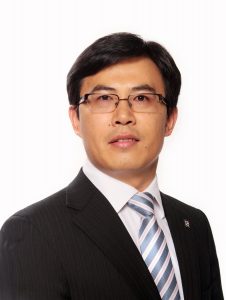NIA Where are they now? Xiujun (James) Li

 Xiujun (James) Li, Assistant Professor in Chemistry & Material Science and Engineering, University of Texas at El Paso (TX, USA)
Xiujun (James) Li, Assistant Professor in Chemistry & Material Science and Engineering, University of Texas at El Paso (TX, USA)
XiuJun (James) Li obtained his Ph.D. degree in microfluidic single-cell analysis with Prof. Paul Li from Simon Fraser University (SFU) in Canada in 2008, he pursued his postdoctoral research in integrated microfluidic devices for genetic analysis with Prof. Richard Mathies at UC Berkeley, and low-cost diagnosis with Prof. George Whitesides at Harvard University, while holding an Postdoctoral Fellowship from Natural Sciences and Engineering Research Council (NSERC) of Canada.
He has gained extensive experiences in bioanalysis using microfluidic systems, such as single-cell analysis, genetic analysis, low-cost diagnosis, pathogen detection, 3D cell culture, and so on.
Dr. Li’s current research interest is centered on the development of innovative microfluidic lab-on-a-chip technologies and nanotechnologies for bioanalysis, environmental analysis and bioengineering. He has authored/coauthored about 50 publications, guest edited a thematic issue in Current Pharmaceutical Biotechnology. He published a book on microfluidic devices with Elsevier in 2013. He has been invited to serve in multiple grant review panels including NSF, NASA and CHIR et al, and multiple journal editorial boards. He is an editor of Scientific Reports from the Nature publishing group.
His research has been funded by National Institute of Health (NIH), UT System, UTEP, State Key Laboratory of Bioreactor Engineering of China and other agencies. He is the recipient of Dean of Graduate Studies Convocation Medal (SFU) in 2009, UT STARS Award in 2012, Outstanding Performance Awards from UTEP in 2013 and 2015 (twice), and an international award of “2014 Bioanalysis Young Investigator Award”.
What are you current working on and what are your career highlights since winning the NIA?
Currently, my research group at University of Texas at El Paso (UTEP) is working on innovative microfluidic lab-on-a-chip platforms for rapid and low-cost infectious disease diagnosis in low-resource settings, especially in global infectious diseases including meningitis, whooping cough, Hepatitis B and TB etc. Some of recent publications include “A versatile PDMS/paper hybrid microfluidic platform for rapid and sensitive infectious diseases diagnosis“, Anal. Chem. 2014, 86 (15), 7978-7986; A paper/polymer hybrid microfluidic microplate for rapid quantitative detection of multiple disease biomarkers, Sci. Rep. 2016, 30474.
I am also working on novel nanotechnologies for low-cost detection of cancer biomarkers and environmental issues. Some of recent publications in this regard include: “Nanoparticle-mediated photothermal effect enables a new method for quantitative biochemical analysis using a thermometer“, Nanoscale 2016, 8, 5422-5427; . Interfacial nano-biosensing in microfluidic droplets for high-sensitivity detection of low-solubility molecules, Chem Comm 2016, 52, 3470-3473. In addition, we are also working on single-cell analysis and 3D cell culture.
Since winning the NIA, multiple awards and tens of publications highlight my career. I received another NIH research grant award and Outstanding Performance Award from UTEP in 2015. In 2016 only, I have published 8 papers. For details, please visit http://li.utep.edu.
What did you hope to achieve when you entered for the award?
When I was nominated for the award, I hoped to receive recognition from my peers and the scientific community through the award.
After years of effort working in the bioanalytical field, it was great to be recognized by the community. . I also hoped thethe award would give me the opportunity to present my research at the European Bioanalysis Forum, which would increase the visibility of my work to my colleagues.
In addition, whether Iwon the award or not, being featured as a nominee on Bioanalysis Zone would definitely increase the visibility of my work to folks worldwide.
What was the impact of receiving the NIA?
I was excited to receive the NIA. I got the opportunity to present my research work at the European Bioanalysis Forum and to exchange research ideas with colleagues at this conference. Barcelona is a charming and historical city to visit.
Right after the award I was invited to serve on the Editorial Advisory Board of a new journal of Future Science OA (open access), as a Young Ambassador. Now I am promoted to be an editor for Future Science OA. I am also an editor of Scientific Reports from Nature Publishing.
Finally another impact of receiving the award was my research started to receive increased attention. My H-index, an author level metric that measures productivity and citation impact of a scientists publication, increased to 18 (Google Scholar).
More talented researchers joined my group to work in the field of bioanalysis. I am very happy to work with them and support them to grow in science and technology and in their career development. Furthermore, the NIA award is also a great encouragement to me. I did not stop there. Receiving the awardinspired continue challenging myself, and to make more significant contributions to the field of bioanalysis.
I also want to take this opportunity to thank the invaluable support from my advisors (Profs. George Whitesides, Richard Mathies and Paul Li) and colleagues.
What are your longer term plans?
Usually analytical methods developed in laboratories are not robust enough to address challenges from the real word. Therefore, after development of innovative microfluidic platforms and nanotechnologies in our laboratory, my longer term plan is to validate these methods using real clinic samples. Applying our methods in gaining a deep insight into biological mysteries is also one of my longer term plans.
We are also interested in collaborating with industrial partners in commercializing our inventions. If some industrial partners are interested in this, feel free contact us by email or phone. For more information, please check our web site. http://li.utep.edu.
What advice would you offer to other scientists new to bioanalysis?
First, I want to say that bioanalysis is a fabulous field to pursue. It is highly interdisciplinary, interfacing chemistry, biology, physics, life science and biomedical engineering. You can learn a lot. And your finding and invention could impact many fields significantly.
In addition, it is a very broad field. I hope you find an interesting niche within this field to pursue. With the addition of more brilliant young people to this field, I am sure this field will become more exciting and energetic. I hope to see your name on the NIA medal list in the near future!
Would you recommend entering the NIA?
Absolutely! I highly recommend this prestigious award to all young investigators, especially to assistant-professor level (or equivalent) young investigators. The NIA will not only increase the visibility of you and your research, but also have significant impact on your career development.
The NIA is attracting increasing attention from the scientific community. I see more and more strong candidates entering this competition. I wish everysuccess to all young investigators both in their nominations for this award and in their career as early-career researchers.




